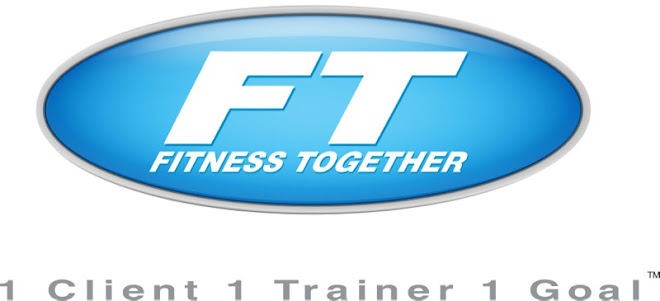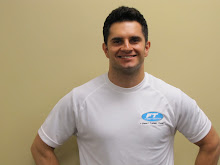Fitness Together Lake Forest
1 Client. 1 Trainer. 1 Goal.
1 Client. 1 Trainer. 1 Goal.
Tuesday, April 6, 2010
Find the Right Show for You
Choosing the right running shoes is one of the most important decisions you'll make as a runner, especially if you're just getting started. A little investment in time and effort for finding the best running shoes will help keep you comfortable and injury-free.
1.Go straight to the experts at a running specialty store. Plan on spending some time there because the salesperson should ask you lots of questions and have several running shoe options for you to try out.
2.Make sure the salesperson looks at the shape and arch to figure out what type of foot you have. Determining your foot type is key to making sure you get the right running shoes. The salesperson should also measure your foot. Your running shoes should be 1/2 to a full size bigger than your regular shoe size because your feet will swell when you run and you need plenty of room in the toebox. If your toes are crammed in the front of the running shoe, you could develop bruised or black toenails.
3.Have the salesperson do a running analysis for you. He'll watch you run in the running shoes, either outside or on treadmill, and determine your running style. He'll observe whether you're overpronating (your foot rolls inward) or supinating (your foot rolls outward) when your foot strikes the ground.
4.Give the salesperson information that will help him with his running shoe recommendations. He should be asking you questions about what type of running you do, how often you run, where you typically run, and what type of surfaces you run on.
5.Run in the running shoes that the salesperson recommends for you. (Make sure you're dressed to run when you're shopping!) Simply trying on the shoes and walking a few steps inside the store is not enough. Run in each pair of shoes to test for fit, function, and comfort before making your final decision.
6.Test your running shoes by running in them for a week. If you quickly develop blisters or foot pain, they may not be the right shoes for you. Many specialty running stores have liberal exchange policies and allow you to return running shoes even if you've been running in them for a week or more. Take them back and exchange them for another recommended pair of running shoes.
7.After you've found your perfect running shoes, you don't have to keep going back to the specialty running shop. You'll need to replace your shoes every 300-400 miles. If you want to save some money, you may be able to find your running shoes online for less money. Search sites such as runbargains.com or Overstock.com for your make and model. And pray that the shoe manufacturer doesn't discontinue your running shoe!
Tips:
1.If you're already a runner, bring your current running shoes with you to the store. The salesperson can look at the wear on the bottom of your running shoes to get some more insight into your running style.
2.Make sure the salesperson measures your foot while you're standing up.
3.If you use orthotics or custom-fit insoles, bring them with you to try on your running shoes. You need running shoes that are roomy enough to accommodate your insoles.
4.Don't pick running shoes based on the colors or style. Just because they look cute doesn't mean they'll be the best running shoe for you!
By Christine Bluff, About.com Guide. March 2010.
Edited for Content by FT Lake Forest Staff
Tuesday, March 30, 2010
Improve Your Technique

Breathing fully and deeply is important in helping you reach your fitness goals. It will have an effect on your workout and how you feel during exercise. If you aren’t focusing on proper breathing technique, exercise may seem more difficult than it needs to. And you may not be taking in enough air to help ignite the burning of fat. Here are some commonly asked questions about how to breathe during exercise:
1. During the “effort”/exertion phase, what’s better: breathing in or breathing out?
Most professionals will tell you to breathe out on the effort phase of an exercise. That means if you’re doing an abdominal crunch, you would breathe out when lifting the trunk. However, this isn’t an absolute must. If you feel more comfortable breathing out during the effort, go for it. The most important thing is that you breathe.
2. What will happen if I don’t breathe enough?
You could find yourself with side stitches. The more rigorous the activity, the more you should breathe and in a steady pattern. Get into a regular rhythm and keep the pace constant. It will help you supply your body with the right amount of oxygen and give you something to focus on. And, your brain will function better too.
3. Is it possible to breath too much or too often?
Well, you could hyperventilate…but it’s pretty unlikely during exercise. When walking or running, get into a steady pattern of breathing out on every fourth step (or any number that feels comfortable for you). For each activity you do, there will be a pattern that feels right. Find that pattern and stick to it.
4. Should I hold my breath during weight work?
No. Holding your breath while bearing down can push blood pressure up significantly. You can also reduce blood flow to your brain and increase pressure in your chest – both of which could be dangerous while exercising.
Pay attention to your body: be aware of your breathing during exercise
The best advice is to become aware of your breathing during your exercise sessions. Think about pushing air out forcefully more than on sucking it in. Breathe in through the nose but realize that when you start working harder you may not be able to bring in enough air that way. If needed, breathe through your mouth. The more serious you are about working out, the more important proper breathing is. Deep breathing can result in a 1-2% competitive edge increase among athletes. That may just mean the difference between winning and losing. So, get into a rhythm, stick to it each time you exercise and you’ll enjoy your workouts more.
By Michele Silence. DietChannel.com. Sept 2006.
Edited for content by FT Lake Forest Staff.
Friday, March 19, 2010
Weight Loss Myths Exposed!
Check out this Runner's World article that talks about 14 weight-loss strategies that just don't work. And learn the best plans for the most success!
Friday, March 12, 2010
Curb Your Cravings...
Follow this link to an article on Health.com to learn easy and unique ways to tackle those unhealthy food cravings.
Wednesday, March 3, 2010
Why Stress Can Breed Bad Habits

When anxious or under pressure, most of us find making conscious choices more difficult -- and the way the brain is wired might be to blame. Researchers at the University of Minho in Portugal recently discovered that stress can activate regions of the brain associated with habitual behavior.
The 2009 study examined chronically stressed rats and found that the segments of the rats' brains linked with decision making shrunk, while regions associated with habit formation thrived. As a result, the rats fell into routines with submissive responses, like compulsively pressing a bar for food even if thay had no intention of eating.
Now although the study is done in rats, this brain connection helps explain why we tend to dig ourselves into ruts when stressed out: The brain seeks solace in repetition, which makes it harder to shift back to intentional behavior -- even if those intentional activities, such as preparing wholesome meals and exercising, are better for our well-being.
The good news is that rats recovered withing four weeks after the stressors were removed, suggesting that stress induced changes in behavior and in the brain may be reversible. You can learn techniques for interrupting stress cycles from the authors at "Experience Life" with the articles 'Three Deep Breaths' (October 2006) and 'Lines of Inquiry' (Decmeber 2004) at experiencelifemag.com.
By Pilar Gerasimo. "Experience Life" Magazine.
Edited for Content by FT Lake Forest Staff
Subscribe to:
Posts (Atom)












